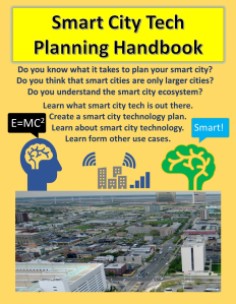Podcast: Play in new window | Download | Embed
Subscribe: Apple Podcasts | RSS
Building a smart city is not easy, nor is adding the infrastructure to create smart city features. It helps to work with partners who have done it before. That is why Deb Socia of Next Century Cities works hard every day to reach out and contact as many communities as possible. Collaboration is the key to getting smart city enhancements in your community. Next Century Cities has a mission to do just that, help all communities elevate through cooperation, or at least help guide them to add smart city services.

The Smart City Tech Planning Handbook, available at:
PDF version on Gumroad: https://gum.co/saDBQ
PDF on Sellfy: https://sellfy.com/p/QAvq/
Amazon Kindle: Click here.
Paperback: Coming soon!
Did you have smart city questions? Did you ever wonder how the city gets the technology to improve local businesses? How does a “smart city” initiative get started? Where can cities go for help? How do they start the high-speed internet initiatives? Where can communities get help to start a tech initiative? What steps can be taken to become a smart city? What can a city do to improve health care, education, quality of life, access to broadband, and make technology affordable to the residents?
Sign-up to get all your updates!
Deb talks about they are helping communities elevate from where they are now to initiating smart city policies so that they can improve technology. While for businesses it is a business initiative. Not so easy for cities. Cities need to get this by multiple departments, raise funds, pass policies, and get buy in from departments, businesses, partners, utilities, and constituents. No easy task. That is why this non-profit group works so hard to make ![]() sure they can find mentors and partners in this venture. In the long run, smart city policies are more about improving the city. Growing the jobs and improving the quality of life. It all goes hand in hand.
sure they can find mentors and partners in this venture. In the long run, smart city policies are more about improving the city. Growing the jobs and improving the quality of life. It all goes hand in hand.
Deb’s group normally starts with local elected officials because they have the dream of improving their city. They are looking for help. They need someone they can trust for help. They cannot just go to the OEMs since they may be looking to sell a solution or push a solution that may not be the best option for the city. The key is to find what the city is what they need, want, and the residents want.
Tower Safety and Instruction has online training and eBooks
at http://teltech-college.com/ where you can get drone, tower, safety, 5G, and deployment material on your laptop! TSI, making the best better.
To get to the next level of a smart city initiative, they may want to see how it’s been done in other cities. Here is where Next Century Cities comes in. Offering a sounding board and a group where one city can learn from another’s initiative. They could provide them a plan based on what’s been done. Maybe they could help them avoid problems. Teach them about the mistakes that other cities have made. Why not learn from what other communities have done? While policies may be different, the desired result may be the same. If they can accelerate the roll out process by initiating real and robust policies, why not?
Testing CDMA and LTE smartphones or UE devices? Get a great deal on a used and affordable ME7834L test setup here!
You need to listen to get all the information. Let’s get a high level of the questions that may help you. Deb is a wonderful resource. Next Century Cities is there to support you. It’s a two-way street, help and be helpful, remember that. T could serve as a sounding board for new ideas. It feels good when you complete a project and let others know so they can learn.
- Did you ever wonder how the city gets the technology to improve local businesses?
- It takes planning.
- What do they normally want? Broadband! While it varies from city to city, goals may differ. Most, if not all want broadband rolled out throughout the city for businesses and residents. Maybe even for tourists.
- How does a “smart city” initiative get started?
- It usually starts with the higher level of governments, the mayor or a CTO or economic development groups may want to improve the internet access to help local businesses grow.
- Why recreate the wheel if it’s been done? Duplicate what others have done.
- Where can cities go for help?
- Next Century Cities has created a network where cities can turn to each other to learn from someone who has done it before. They have provided a platform to share ideas.
- How do they start the high-speed internet initiatives?
- They could start with business partnerships. Learning what has worked in other areas and what vendors have solutions. They could leverage their utility partners to help.
- Building infrastructure to support city-wide broadband need planning and support.
- Where can communities go to for help in starting a tech initiative?
- It could be the OEMs, consultants, or fellow cities that have already done it.
- Whom do you trust the most? If another city has done it, then you have a model.
- Next Century Cities is a great place to start.
- What steps can be taken to become a smart city?
- Not an easy question, first, define what smart city means to you and your community, then develop a plan for policies and technical requirements. The foundation is the key, then build on it.
- What can a city do to improve health care, education, quality of life, access to broadband, and make technology affordable to the residents?
- Roll out broadband, build the infrastructure, create policies that enable this to happen quickly and efficiently.
- Who can join Next Century Cities?
- Communities, cities, counties, any government organization looking to help or get help in creating s smart city initiative.
- Vendors can contact and support Next Century Cities, maybe become partners, but not become a member.
- Where can I learn more about smart cities?
- Next Century Cities has a great resource page, http://nextcenturycities.org/resources/ where you can see articles in the main list, but at the bottom left they have the resources broken down to help you understand specific areas, like pole attachments and small cells.
- What are Next Century Cities principles? Found at http://nextcenturycities.org/wp-content/uploads/Next-Century-Cities-Two-Pager.pdf.
- High-Speed Internet Is Necessary Infrastructure
- The Internet Is Nonpartisan
- Communities Must Enjoy Self-Determination
- High-Speed Internet Is a Community-Wide Endeavor
- Meaningful Competition Drives Progress
- Collaboration Benefits All
- How do I join Next Century Cities?
- Look at their membership map at http://nextcenturycities.org/members/ and then go to http://nextcenturycities.org/contact/ and sign up.
- How can I support Next Century Cities?
- Go to https://www.crowdrise.com/helpsupportnextcenturycities and give what you can.
The Wireless Deployment Handbook Paperback
The Wireless Deployment Handbook eBook that covers professional carrier end to end deployment of LTE small cells, CRAN, and DAS showing you the proper way to plan for deployment then execute.
Deb Socia is the Executive Director of Next Century Cities, an innovative organization that helps cities develop city initiatives and policies for the infrastructure. They do this by connecting communities so that someone starting out can learn from the more experienced cities. Going beyond technical initiatives and into the city policies and planning. When communities want to move ahead, it helps to talk to someone who has done it before. Contact Den through the contact page or at Deb@nextcenturycities.org.
Next Century Cities is a nonprofit organization for communities to become connected and learn from each other and teach each other how to get to the next level or do something specific. To find out more go to http://nextcenturycities.org/about/overview/ or download the information sheet at http://nextcenturycities.org/wp-content/uploads/Next-Century-Cities-Two-Pager.pdf to get a good overview of what they offer. Contact Next Century Cities at http://nextcenturycities.org/contact/ to join or learn more.
How do you plan goals? Now you can plan 5 Weeks at a time! The 5-week Planning Journal, (click here), available now in paperback from Amazon!
Be smart, be safe, and pay attention!
See Ya!
The foundations below do beautiful work, helping families in their time of need. Climbers often get seriously injured or die on the job. The foundations below support those families in their time of greatest need!
Hubble Foundation helps the families of climbers in a time of need and beyond with financial support and counseling!
Tower Family Foundation supports the families of tower climbers at the time of crisis when a climber falls with financial assistance and more.















